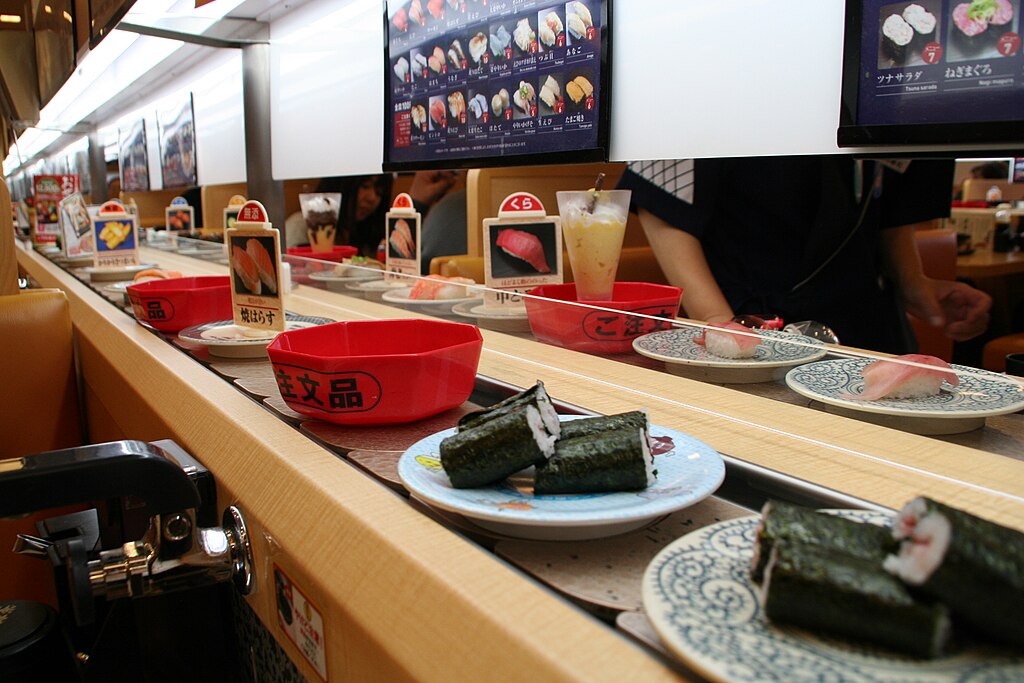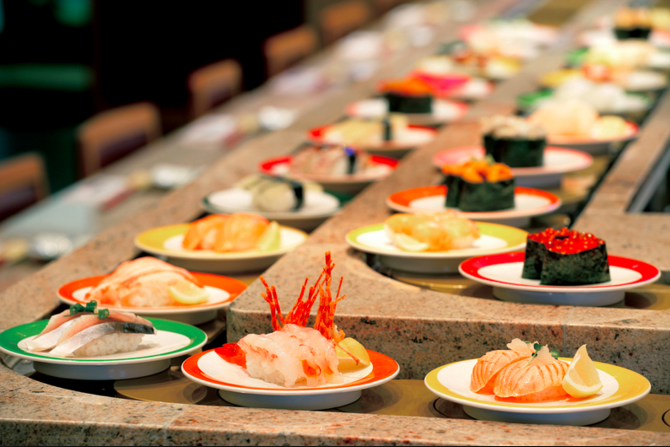If you’ve ever dreamed of eating sushi in Japan without breaking the bank, kaitenzushi (回転寿司) — conveyor belt sushi — is your perfect match. This quirky, fast-paced style of dining offers a wide variety of sushi at prices so low you’ll feel like you’re getting away with something.
You simply sit down, watch plates of freshly made sushi glide past you on a conveyor belt, and pick up whatever catches your eye. No fuss, no long waits, no intimidating menus.
It’s a casual, fun, and surprisingly addictive way to eat sushi — and it’s just as popular with Japanese locals as it is with visitors.
A Brief History of Kaitenzushi
Kaitenzushi first appeared in Osaka in 1958, invented by Yoshiaki Shiraishi, who was inspired by… beer. More specifically, by the way beer bottles moved along automated conveyor systems in a brewery. He wondered if sushi could be served the same way, making it faster and more affordable for everyone.
That spark of inspiration gave birth to a dining style that has since spread all over Japan — and even worldwide. Today, you’ll find kaitenzushi chains in almost every city, each with its own gimmicks, pricing, and specialties.
How It Works
When you arrive, you’ll be shown to a seat or booth next to the conveyor belt. Two main types of belts are common:
- Continuous belt — sushi travels in a loop until someone picks it up.
- Direct delivery lane — you order via touchscreen, and your plate zooms straight to you on a mini bullet train or boat-shaped tray.
Every plate is color-coded according to price. When you’re done eating, staff count your plates to calculate your bill.

What You Can Expect to Eat
Sure, you’ll see classics like maguro (tuna), ebi (shrimp), and sake (salmon), but kaitenzushi menus often go far beyond the usual sushi bar offerings. Depending on the season and chain, you might find:
- Aburi sushi — lightly torched fish for a smoky aroma.
- Uni (sea urchin) — creamy, briny, and a treat for adventurous eaters.
- Creative rolls topped with mayonnaise, fried onions, or spicy sauces.
- Non-sushi dishes like ramen, fried chicken, and desserts.
The Affordable Side of Sushi
One of the biggest draws of kaitenzushi is the price. Plates often start at just ¥100–¥150 (around $1–$1.50 USD) each. This means you can fill up without the eye-watering bill that sometimes comes with high-end sushi restaurants.
Even premium items like fatty tuna or sea urchin are far cheaper here than in upscale places, making it a fantastic introduction for first-time sushi eaters.
Fun Extras at Kaitenzushi
Modern kaitenzushi restaurants are more than just conveyor belts. Many have turned dining into a mini-adventure:
- Digital ordering screens let you choose in multiple languages.
- Automated plate returns sometimes trigger rewards, like mini capsule toys after every 5 plates.
- Dessert options such as parfaits, mochi ice cream, or seasonal cakes.
- Specialty drinks like matcha, refillable at your table.
Etiquette Tips for First-Timers
- Only touch the plate you plan to take.
- Don’t return a plate once it’s been removed from the belt.
- Place empty plates in the stack by your seat so staff can count them later.
- Use the hot water dispenser and matcha powder for complimentary tea.
Where to Try Kaitenzushi
Some popular national chains include:
- Sushiro (スシロー) — affordable and great variety.
- Kura Sushi (くら寿司) — known for their capsule toy prizes.
- Genki Sushi (元気寿司) — touchscreen ordering with speedy delivery.
- Hamazushi (はま寿司) — big selection and seasonal specials.
Why It’s More Than Just a Meal
Kaitenzushi isn’t just about eating — it’s about the experience. The excitement of seeing your favorite sushi roll glide toward you, the satisfaction of stacking up colorful plates, and the joy of discovering something new all make it an unforgettable part of any trip to Japan.
It’s casual enough for a quick solo lunch, but fun enough for families and friends to make an event out of it. And whether you eat three plates or ten, you’ll leave feeling full, satisfied, and slightly in awe of how efficient (and fun!) Japanese dining can be.

